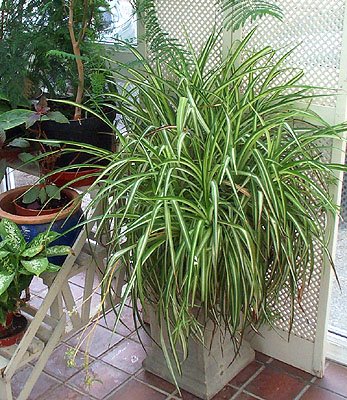
Scientific Name : Chlorophytum comosum
Common Name : Spider Plant ; St. Bernard's lily
Scientific Classification
Kingdom Plantae
Division Magnoliophyta
Class Liliopsida
Order Asparagales
Family Agavaceae
Genus Chlorophytum
Species C. comosum

Like privet hedges in the garden the chlorophytums of the houseplant world appear to be everywhere. Yet they are not always as bright and healthy as their ease of culture would suggest they should be - in fact, many are extrememly poor specimens. This may be due to the fact that owners feel that they are so easy to grow that they don't have to bother at all.
Give the chlorophytum good light to prevent it becoming thin and straggly, and keep it moist at all times, especially during summer.
The most important need of all and the one most neglected, is that of feeding, and feeding the spider plant means giving it very much more than the average indoor plant. Frequent potting on is also essential, and this could be necessary twice a year for vigourous plants. Spider plants produce large fleshy roots and quickly become starved if not supplied with sufficient nourishment. Use a loam-based potting mixture.
Description:
A tufted grass-like perennial herb, to 60cm high. Leaves are grass-like, and may be solid green, although the variegated form with pale green and white longitudinal stripes is more common. Flowers are white with six petals, in branching heads. Small plantlets are produced at the tips of the flowering branches. When the branches bend over and the plantlets come into contact with the soil they take root.
Preferred habitat and impacts:
Occasionally found naturalised near towns, as a result of dumping of garden waste in accessible spots. Individual clumps can spread quite extensively, excluding native plants.
Dispersal:
Dumping, vegetative spread by plantlets leading to gradually increasing clump size.
Look-alikes
No very similar plants, particularly of the variegated form.
Control
Do not dump garden waste. This plant is unlikely to spread into native vegetation without such assistance. Plants can be dug and burnt or deeply buried to prevent them re-sprouting, or sprayed.
Blooming Period: spring summer fall
Height: up to 16 inches
Foliage Texture: medium
Heat Tolerance: high
Water Requirements: medium
Additional Comments:Aphids cause blotched leaves

No comments:
Post a Comment